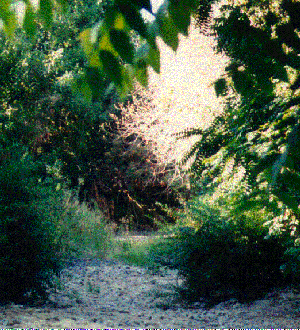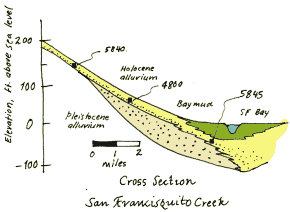|
IGNATIUS DONNELLY
AND THE END OF THE WORLD
 hat do you seek
in uncertain times? I believe it is a measure of assurance obtainable only
by prognostication. I aim to satisfy this by three means. hat do you seek
in uncertain times? I believe it is a measure of assurance obtainable only
by prognostication. I aim to satisfy this by three means.
First by calling to the stand as witnesses certain bones.
The testimony of the bones!
Recently I visited the site of a remarkable find. It was
in a shady glen,
a grotto carved out into the bank of San Francisquito Creek, about fifteen
feet below the street level, not far from the original residence of Senator
Stanford (a contemporary of mine who bought much of the land flanking the
creek in the 1880s, a time when my great real estate speculation had dissolved
into a fiasco and I was recovering from that blow by writing my famous
book on Atlantis[1]) There has subsequently been been at least two skulls
found at this same location. The first in early 1922, in April or May,
by a glen,
a grotto carved out into the bank of San Francisquito Creek, about fifteen
feet below the street level, not far from the original residence of Senator
Stanford (a contemporary of mine who bought much of the land flanking the
creek in the 1880s, a time when my great real estate speculation had dissolved
into a fiasco and I was recovering from that blow by writing my famous
book on Atlantis[1]) There has subsequently been been at least two skulls
found at this same location. The first in early 1922, in April or May,
by a  student
named Bruce Seymore. He found the skull sticking out of those gravels
about 6 feet above the ground. This young man took the skull to Professor
Willis of the geology department who after returning to the creek to photograph
the skull at the point of its discovery, advised a friend of his, Doctor
Alex Hrdlicka, of the National Museum. student
named Bruce Seymore. He found the skull sticking out of those gravels
about 6 feet above the ground. This young man took the skull to Professor
Willis of the geology department who after returning to the creek to photograph
the skull at the point of its discovery, advised a friend of his, Doctor
Alex Hrdlicka, of the National Museum.
My Dear Doctor Hrdlicka: Although it is more than 12
years since you and I rejuvenated an ancient man in South America, you
are, I notice, still interested in our older inhabitants and I would, therefore,
call your attention to a skull, which we have recently found in the alluvial
gravels of this immediate vicinity...
Soon after the doctor wrote back saying that he thought
that the skull was  probably
not much older than ten thousand years, humans of those days being at best
very scarce on the continent. Professor Willis had judged that the geological
deposits in which the skull was found were more than four thousand years
old. Considering the extreme difficulty of absolute dating in those days,
these estimates, bracketing it between four and ten thousand years old,
are remarkably good, as subsequent events were to show.[2] probably
not much older than ten thousand years, humans of those days being at best
very scarce on the continent. Professor Willis had judged that the geological
deposits in which the skull was found were more than four thousand years
old. Considering the extreme difficulty of absolute dating in those days,
these estimates, bracketing it between four and ten thousand years old,
are remarkably good, as subsequent events were to show.[2]
In the spring of 1963 part of a human vertabra was exposed
on the other side of the creek, nearby, at a depth of sixteen and a half
feet. The skeleton was excavated by Stanford University Professor Bert
Gerow and some students who discovered it to be a young man who had been
buried oriented North seventy degrees east along with three arrowheads
of Monterey chert, two rodent incisors, an eccentric pebble of probable
marine origin, and a fragment of the milk canine of a large carnivore,
probably a bear. There was enough charcoal to date the burial at 4350 and
4400 radiocarbon years before present. Depth of burial was sixteen feet
below the level of the present ground.
3000 BC [3]. A thousand six hundred years before the fall
of Troy!
FOOTNOTES
[1] Donnelly, Atlantis, 1882
[2] One senses that an objective of this academic interest
was to demonstrate the antiquity of man, thus denying the prospect of special
creation. See Gerow for background on these finds.
[3] Radiocarbon years are subject to correction (add
600 years in this age range) to attain our conventional calendar years,
which I shall here set forth in the traditional BC/AD form.
[4] Note
the stratigraphic position of the skull at the point indicated as being
5840 BP. Note
the stratigraphic position of the skull at the point indicated as being
5840 BP.
NEXT
TABLE
OF CONTENTS
READERS'
DISCUSSION
|
 hat do you seek
in uncertain times? I believe it is a measure of assurance obtainable only
by prognostication. I aim to satisfy this by three means.
hat do you seek
in uncertain times? I believe it is a measure of assurance obtainable only
by prognostication. I aim to satisfy this by three means.
 glen,
a grotto carved out into the bank of San Francisquito Creek, about fifteen
feet below the street level, not far from the original residence of Senator
Stanford (a contemporary of mine who bought much of the land flanking the
creek in the 1880s, a time when my great real estate speculation had dissolved
into a fiasco and I was recovering from that blow by writing my famous
book on Atlantis[1]) There has subsequently been been at least two skulls
found at this same location. The first in early 1922, in April or May,
by a
glen,
a grotto carved out into the bank of San Francisquito Creek, about fifteen
feet below the street level, not far from the original residence of Senator
Stanford (a contemporary of mine who bought much of the land flanking the
creek in the 1880s, a time when my great real estate speculation had dissolved
into a fiasco and I was recovering from that blow by writing my famous
book on Atlantis[1]) There has subsequently been been at least two skulls
found at this same location. The first in early 1922, in April or May,
by a  student
named Bruce Seymore. He found the skull sticking out of those gravels
about 6 feet above the ground. This young man took the skull to Professor
Willis of the geology department who after returning to the creek to photograph
the skull at the point of its discovery, advised a friend of his, Doctor
Alex Hrdlicka, of the National Museum.
student
named Bruce Seymore. He found the skull sticking out of those gravels
about 6 feet above the ground. This young man took the skull to Professor
Willis of the geology department who after returning to the creek to photograph
the skull at the point of its discovery, advised a friend of his, Doctor
Alex Hrdlicka, of the National Museum.
 probably
not much older than ten thousand years, humans of those days being at best
very scarce on the continent. Professor Willis had judged that the geological
deposits in which the skull was found were more than four thousand years
old. Considering the extreme difficulty of absolute dating in those days,
these estimates, bracketing it between four and ten thousand years old,
are remarkably good, as subsequent events were to show.[2]
probably
not much older than ten thousand years, humans of those days being at best
very scarce on the continent. Professor Willis had judged that the geological
deposits in which the skull was found were more than four thousand years
old. Considering the extreme difficulty of absolute dating in those days,
these estimates, bracketing it between four and ten thousand years old,
are remarkably good, as subsequent events were to show.[2]
 Note
the stratigraphic position of the skull at the point indicated as being
5840 BP.
Note
the stratigraphic position of the skull at the point indicated as being
5840 BP.